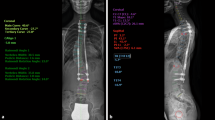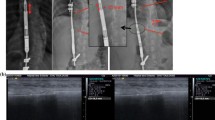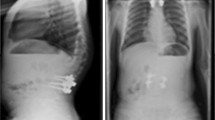Abstract
Introduction
Magnetically controlled growing rods (MCGR) for the surgical treatment of early onset scoliosis (EOS) allow non-invasive outpatient based distractions during spinal growth. The purpose of this study is to present the results of a single center case series of 22 patients, evaluate the effect of MCGR treatment on the development of spino-pelvic parameters during growth, and report initial outcomes after end of treatment.
Materials and methods
Prospectively collected data of 22 EOS patients with MCGR treatment has been analyzed. The following radiological parameters were measured before index surgery, after index surgery, 1 year after index surgery, and at last follow-up: Cobb angle of the major curves, thoracic kyphosis (TK), lumbar lordosis (LL), sagittal vertical axis (SVA), pelvic incidence (PI), pelvic tilt (PT), and sacral slope (SS). Mean age at index surgery was 9.5 years (range: 4–14 years). Mean length of follow-up was 47.6 months (range: 25–121 months). Etiology of diagnosis was idiopathic in 14 patients, associated with neurofibromatosis in 2 patients, and neuromuscular or syndromic in 6 patients.
Results
Mean Cobb angle of the major curve was 57° preoperatively and 29° at last follow-up (p < 0.0005). Mean TK was 20.1° preoperatively and 20° at last follow-up (p > 0.05). Mean LL was 52.8° preoperatively and 53.2° at last follow-up (p > 0.05). Mean PI was 43.2° preoperatively and 46.3° at last follow-up (p > 0.05). Mean PT was 4.1° preoperatively and 5.8° at last follow-up (p > 0.05). Mean SS was 39.2° preoperatively and 41.7° at last follow-up (p > 0.05). 14 patients finished treatment: nine received final fusion and five received rod removal without fusion. Twelve complications occurred: one deep wound infection, six patients developed proximal junctional kyphosis (PJK), one rod fracture, two rods failed to distract, one deformity progressed after rod removal and required spinal fusion, and one patient developed autofusion of the spine prior to end of treatment.
Conclusion
MCGR treatment is able to control deformity progression. Complication rate was 54.5%. Sagittal balance was not altered and treatment does not seem to have a negative impact on the development of spino-pelvic parameters during growth. Optimal end of treatment for the individual patient still has to be defined.








Similar content being viewed by others
References
Campbell RM, Smith MD, Mayes TC et al (2003) The characteristics of thoracic insufficiency syndrome associated with fused ribs and congenital scoliosis. J Bone Jt Surg Am 85-A:399–408
Pehrsson K, Larsson S, Oden A, Nachemson A (1992) Long-term follow-up of patients with untreated scoliosis. A study of mortality, causes of death, and symptoms. Spine 17:1091–1096
Karol LA (2019) The natural history of early-onset scoliosis. J Pediatr Orthop 39:S38–S43. https://doi.org/10.1097/BPO.0000000000001351
Vitale MG, Matsumoto H, Bye MR et al (2008) A retrospective cohort study of pulmonary function, radiographic measures, and quality of life in children with congenital scoliosis: an evaluation of patient outcomes after early spinal fusion. Spine 33:1242–1249
Akbarnia BA, Breakwell LM, Marks DS et al (2008) Dual growing rod technique followed for three to eleven years until final fusion: the effect of frequency of lengthening. Spine 33:984–990
Akbarnia BA, Marks DS, Boachie-Adjei O et al (2005) Dual growing rod technique for the treatment of progressive early-onset scoliosis: a multicenter study. Spine 30:S46–57
Sankar WN, Acevedo DC, Skaggs DL (2010) Comparison of complications among growing spinal implants. Spine 35:2091–2096
Cheung KMC, Cheung JPY, Samartzis D et al (2012) Magnetically controlled growing rods for severe spinal curvature in young children: a prospective case series. Lancet 379:1967–1974
Heydar AM, Şirazi S, Bezer M (2016) Magnetic controlled growing rods as a treatment of early onset scoliosis. Spine 41:E1336–E1342
Hosseini P, Pawelek J, Mundis GM et al (2016) Magnetically controlled growing rods for early-onset scoliosis. Spine 41:1456–1462
La Rosa G, Oggiano L, Ruzzini L (2017) Magnetically controlled growing rods for the management of early-onset scoliosis. J Pediatr Orthop 37:79–85
Cheung JP-Y, Samartzis D, Cheung KM-C (2014) A novel approach to gradual correction of severe spinal deformity in a pediatric patient using the magnetically-controlled growing rod. Spine J 14:e7–13
Cheung JPY, Bow C, Samartzis D et al (2016) Frequent small distractions with a magnetically controlled growing rod for early-onset scoliosis and avoidance of the law of diminishing returns. J Orthop Surg 24:332–337
Cheung JPY, Cahill P, Yaszay B et al (2015) Special article: update on the magnetically controlled growing rod: tips and pitfalls. J Orthop Surg 23:383–390
Cheung JPY, Yiu K, Kwan K, Cheung KMC (2019) Mean 6-year follow-up of magnetically controlled growing rod patients with early onset scoliosis: a glimpse of what happens to graduates. Neurosurgery 84:1112–1123. https://doi.org/10.1093/neuros/nyy270
Cheung JPY, Yiu KKL, Samartzis D et al (2018) Rod lengthening with the magnetically controlled growing rod: factors influencing rod slippage and reduced gains during distractions. Spine 43:E399–E405. https://doi.org/10.1097/BRS.0000000000002358
Obid P, Yiu KKL, Cheung KM et al (2018) Reliability of rod lengthening, thoracic, and spino-pelvic measurements on biplanar stereoradiography in patients treated with magnetically controlled growing rods. Spine 43:1579–1585. https://doi.org/10.1097/BRS.0000000000002671
Nnadi C, Thakar C, Wilson-MacDonald J et al (2018) An NIHR-approved two-year observational study on magnetically controlled growth rods in the treatment of early onset scoliosis. Bone Jt J 100:507–515. https://doi.org/10.1302/0301-620X.100B4.BJJ-2017-0813.R1
Lebon J, Batailler C, Wargny M et al (2017) Magnetically controlled growing rod in early onset scoliosis: a 30-case multicenter study. Eur Spine J 26:1567–1576. https://doi.org/10.1007/s00586-016-4929-y
Jackson RP, Hales C (2000) Congruent spinopelvic alignment on standing lateral radiographs of adult volunteers. Spine 25:2808–2815
Marty C, Boisaubert B, Descamps H et al (2002) The sagittal anatomy of the sacrum among young adults, infants, and spondylolisthesis patients. Eur Spine J 11:119–125. https://doi.org/10.1007/s00586-001-0349-7
Legaye J, Duval-Beaupère G, Hecquet J, Marty C (1998) Pelvic incidence: a fundamental pelvic parameter for three-dimensional regulation of spinal sagittal curves. Eur Spine J 7:99–103
Vialle R, Levassor N, Rillardon L et al (2005) Radiographic analysis of the sagittal alignment and balance of the spine in asymptomatic subjects. J Bone Jt Surg Am 87:260–267. https://doi.org/10.2106/JBJS.D.02043
Mac-Thiong J-M, Berthonnaud E, Dimar JR et al (2004) Sagittal alignment of the spine and pelvis during growth. Spine 29:1642–1647
Mac-Thiong J-M, Labelle H, Berthonnaud E et al (2007) Sagittal spinopelvic balance in normal children and adolescents. Eur Spine J 16:227–234. https://doi.org/10.1007/s00586-005-0013-8
Cil A, Yazici M, Uzumcugil A et al (2005) The evolution of sagittal segmental alignment of the spine during childhood. Spine 30:93–100
Swank SM, Mauri TM, Brown JC (1990) The lumbar lordosis below Harrington instrumentation for scoliosis. Spine 15:181–186
Thakar C, Kieser DC, Mardare M et al (2018) Systematic review of the complications associated with magnetically controlled growing rods for the treatment of early onset scoliosis. Eur Spine J 27:2062–2071. https://doi.org/10.1007/s00586-018-5590-4
Makino T, Kaito T, Sakai Y et al (2019) Health-related quality of life and postural changes of spinal alignment in female adolescents associated with back pain in adolescent idiopathic scoliosis: a prospective cross-sectional study. Spine. https://doi.org/10.1097/BRS.0000000000002996
Atici Y, Akman YE, Erdogan S et al (2015) The effect of growing rod lengthening technique on the sagittal spinal and the spinopelvic parameters. Eur Spine J 24:1148–1157
Bekmez S, Demirkiran HG, Dede O et al (2019) Spinal instrumentation in growing children retards the natural development of pelvic incidence. J Pediatr Orthop 39:141–145. https://doi.org/10.1097/BPO.0000000000000882
Schlösser TPC, Janssen MMA, Vrtovec T et al (2014) Evolution of the ischio-iliac lordosis during natural growth and its relation with the pelvic incidence. Eur Spine J 23:1433–1441. https://doi.org/10.1007/s00586-014-3358-z
Shah SA, Karatas AF, Dhawale AA et al (2014) The effect of serial growing rod lengthening on the sagittal profile and pelvic parameters in early-onset scoliosis. Spine 39:E1311–E1317
Pepke W, Almansour H, Diebo BG, Akbar M (2019) Correction of the spine with magnetically controlled growing rods in early onset scoliosis: a pre-to-post analysis of 21 patients with 1-year follow-up. Orthopade. https://doi.org/10.1007/s00132-019-03801-x
Kwan KYH, Alanay A, Yazici M et al (2017) Unplanned reoperations in magnetically controlled growing rod surgery for early onset scoliosis with a minimum of two-year follow-up. Spine 42:E1410–E1414. https://doi.org/10.1097/BRS.0000000000002297
Cheung JPY, Yiu KKL, Samartzis D et al (2018) Rod lengthening with the magnetically controlled growing rod. Spine 43:E399–E405. https://doi.org/10.1097/BRS.0000000000002358
Sankar WN, Skaggs DL, Yazici M et al (2011) Lengthening of dual growing rods and the law of diminishing returns. Spine 36:806–809. https://doi.org/10.1097/BRS.0b013e318214d78f
Subramanian T, Ahmad A, Mardare DM et al (2018) A six-year observational study of 31 children with early-onset scoliosis treated using magnetically controlled growing rods with a minimum follow-up of two years. Bone Jt J 100B:1187–1200. https://doi.org/10.1302/0301-620X.100B9.BJJ-2018-0031.R2
Jain A, Sponseller PD, Flynn JM et al (2016) Avoidance of “final” surgical fusion after growing-rod treatment for early-onset scoliosis. J Bone Jt Surg Am 98:1073–1078. https://doi.org/10.2106/JBJS.15.01241
Funding
There is no funding source.
Author information
Authors and Affiliations
Corresponding author
Ethics declarations
Conflict of interest
The authors declare that they have no conflict of interest.
Ethical approval
Ethics approval for this study was obtained from the institutional review board.
Additional information
Publisher's Note
Springer Nature remains neutral with regard to jurisdictional claims in published maps and institutional affiliations.
Rights and permissions
About this article
Cite this article
Obid, P., Yiu, K., Cheung, K. et al. Magnetically controlled growing rods in early onset scoliosis: radiological results, outcome, and complications in a series of 22 patients. Arch Orthop Trauma Surg 141, 1163–1174 (2021). https://doi.org/10.1007/s00402-020-03518-z
Received:
Published:
Issue Date:
DOI: https://doi.org/10.1007/s00402-020-03518-z




